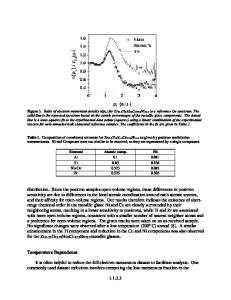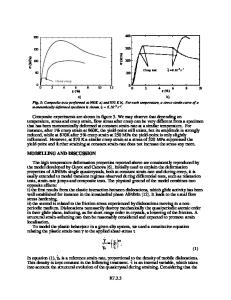Icosahedral ordering in quasicrystals and metallic glasses
- PDF / 428,400 Bytes
- 3 Pages / 595.44 x 841.68 pts Page_size
- 84 Downloads / 358 Views
Icosahedral ordering in quasicrystals and metallic glasses J. C. Phillips AT&T Bell Laboratories, Murray Hill, New Jersey 07974 (Received 11 October 1985; accepted 6 December 1985) Many workers have recently conjectured that the underlying forces responsible for icosahedral clustering in crystals may also explain the origin of metallic glass formation. Critical examination of thermochemical structural diagrams and radial distribution functions of good metallic glasses shows that this assertion is unfounded.
The remarkable discovery1 of long-range icosahedral order in metastable 103 nm grains of Al6Mn obtained by rapid quenching from the melt apparently constitutes realization of Tammann's long-standing glass-formation conjecture2 concerning frustration of crystallization by icosahedral short-range order. During intervening decades it has often been suggested3"6 that icosahedral short-range order may be the primary mechanism responsible for the formation of common metallic glasses A.l_xBx with x near 0.2 and (A,B) = (Pt,Si), (Ni,P), (Fe,B), etc. Recently these suggestions have been generalized7 to include all noncrystalline solids based on 12-fold coordination. For example, just as icosahedral coordination is a 12-fold alternative to close packing, it has been suggested7 that some kind of icosahedral second-neighbor coordination may apply to amorphous GaAs, because crystalline GaAs consists of two interpenetrating close-packed lattices. The purpose of this comunication is to present a brief and more balanced review of the literature which describes the limitations of the real-space icosahedral approach and treats both structural and thermodynamic considerations. First it should be noted that quenching kinetics and mechanical stability jointly influence the formation of rapidly quenched material. Close parallels between the dependence on x of the equilibrium liquidus Tt and the glass Tg temperatures are found for the best binary network glass alloys, but these parallels vanish with degradation of the glass-forming tendency.8 In Al-Mn alloys quasicrystals are formed in a composition range dominated by a cascade of peritectic compounds (Alp Mn, with/) = 2,3,4, and 6). By contrast the signature 9 of common metallic glasses is the proximity of these compositions x to a deep eutectic composition xe with LT,/fe = - 0.2 to - 0.4. [Here f, is the average of T, at adjacent congruently melting compounds and A7-, = ! - , ( * , ) - 7 " , . ] J. Mater. Res. 1 (1), Jan/Feb 1986
http://journals.cambridge.org
Villars has used structural diagrams to examine the origins of eutectic and peritectic behavior in metallic alloys.10 First he has shown that to obtain a eutectic in a binary alloy A^Bj _x, it is necessary that A and B have different crystal structures. This means that spherepacking models cannot describe eutectic alloys, because substantial differences in the noncentral or directional interatomic forces are needed to generate different crystal structures. Second, the same diagrams show that the nature of interatomic forces
Data Loading...











